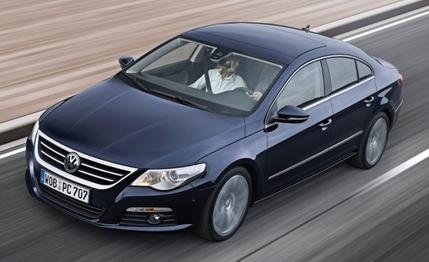 First Drive Review
First Drive Review
When was the last time you heard somebody, anybody, describe a Volkswagen as sexy? Don't get us wrong, Volkswagen cars have their appeal, and we're particularly fond of the GTI, but they don't have the kind of attractiveness that inspires teen-age boys to put a poster on their bedroom walls. The Passat CC isn't really that type of car, either, but it's a step in that direction and, depending on your styling preferences, could even be considered sexy.
Volkswagen calls the Passat CC a four-door coupe. If that sounds familiar, it's because that is exactly how Mercedes-Benz describes its CLS-class. The Passat CC unashamedly borrows from that idea, taking most of its underpinnings from the standard Passat, as does the CLS from the E-class. But instead of everyday-family-sedan styling, the Passat CC looks, well, more like a coupe. The windshield and the roofline are more steeply raked, and the body is longer (by 0.7 inch), lower (by 2.2 inches), and wider (by 1.3 inches); the wheelbase is the same. Besides the unique sheetmetal, the Passat CC has unique doors, seats, and instruments. All told, VW tells us the CC version shares about 50 percent of its parts with the original sedan.
True to the coupe theme, the Passat CC has only two seats in back, with a small storage console and fold-down armrest in the middle. Unlike in a coupe, there’s actually plenty of legroom. Headroom isn’t as much of a compromise as the roofline would suggest and is far better than that of the Mercedes CLS. Passengers over six feet tall will be brushing the headliner, but anyone shorter will find plenty of comfort.
As one would expect considering the similarities, the Passat CC drives just like a Passat. The steering is sharp, if somewhat lacking in feel, and the suspension is taut but compliant over rough surfaces. When the Passat CC goes on sale this fall, U.S.-bound cars will come with a 200-hp, 2.0-liter turbocharged four or a 280-hp, 3.6-liter V-6.
The V-6 can also be ordered with 4MOTION, Volkswagen’s all-wheel-drive system. Our preview drive, however, was in European-spec cars with slightly different engines. The 3.6-liter over there makes 295 horsepower, and the turbo engine is a 158-hp 1.8-liter. Even with the large difference in outputs, we still prefer the quick-revving turbo with a manual transmission. The V-6 feels heavier in front, and the dual-clutch transmission (which won’t be available in the U.S.; we get a traditional six-speed automatic) is slow to react unless you’re using the manumatic mode.
The European-market Passat CC can be ordered with adaptive cruise control, ventilated front seats, and lane departure prevention, but those options won’t make it to North America, at least initially. We do get available adjustable shocks and a new, touch-screen navigation system that’s a big improvement over VW’s current navigation.
Overall, the Passat CC is a good compromise between style and practicality, especially if you don’t need to transport four passengers at once. The catch, then, is the price. Actual numbers haven’t been announced yet, but expect to pay from $1500 to $2000 more than the cost of a Passat for its faux-coupe brother: roughly $27,000 for a base 2.0T, $38,500 for the V-6, and about $40,000 for a V-6 with all-wheel drive.